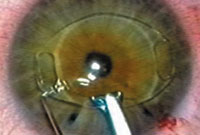Phakic IOLs hold promise for the future of refractive surgery
NEW YORK — Although LASIK currently remains at the forefront of refractive surgery technology, the recent Food and Drug Administration approval of the Artisan/Verisyse lens (Ophtec/Advanced Medical Optics) appears to have ushered in an exciting new era for phakic IOLs.
|
|
“While LASIK still remains king of refractive surgery, I can see these lenses challenging it over the next 5 or 6 years; 2005 will be the year phakic IOLs and lens implants in general become important to all of our practices,” said Eric D. Donnenfeld, MD, FACS, of Ophthalmic Consultants of Long Island.
Dr. Donnenfeld, along with Marc R. Bloomenstein, OD, FAAO, and Paul M. Karpecki, OD, FAAO, spoke on the topic of “The role of phakic IOLs in today’s refractive practice” at the fourth annual Primary Care Optometry News Symposium in New York.
In his presentation, Dr. Donnenfeld said patient satisfaction is one of the most notable benefits of phakic IOLs. “There’s nothing like taking a patient with –17 D and offering vision better than anything he or she has ever had,” he said.
Dr. Donnenfeld said, in the future, phakic IOLs could be preferable to LASIK for emerging presbyopes. “What if I could say to my patients that I could put a lens in their eyes with multifocal optics?” he said. “It will revolutionize refractive surgery.”
According to the AMO Web site, the Verisyse lens is approved for reducing or eliminating myopia between 5 and 20 D.
Dr. Karpecki, a Primary Care Optometry News Editorial Board member who practices at Moyes Eye Center in Kansas City, Mo., said the approval range for this type of lens may eventually extend to –24 D.
Bioptics: the best of LASIK and IOLs
Another exciting possibility for the future of refractive surgery is bioptics, which is the combination of phakic implants and LASIK or photorefractive keratectomy to correct the highest refractive errors.
“Because procedures with phakic IOLs are spherical, the astigmatism will have to be corrected in a separate procedure,” Dr. Karpecki said in an interview with Primary Care Optometry News. “Options to correct astigmatism include PRK, LASIK, astigmatic keratotomy or limbal relaxing incisions.”
The lens implant can correct hyperopia between approximately 3 and 7 D and myopia between 10 and 20 D. The subsequent LASIK, performed a few weeks later, can correct another –10 D or +3 D as well as any accompanying astigmatism, he said.
According to Dr. Donnenfeld, the combination procedure has yielded “extraordinary results,” he said. “IOLs still have faults. They can’t correct astigmatism and they can’t correct higher-order aberrations. So, in some cases, it would be beneficial to bring patients back for laser.”
Multifocal phakic IOLs
Although no phakic multifocal IOLs are yet FDA approved, research in this area has yielded positive early results. According to Dr. Bloomenstein, Georges Baikoff, MD, at the Clinique Monticelli in Marseilles, France, examined the efficacy of a foldable, angle-supported bifocal phakic implant, the Vivarte (IOLTech). The study looked at patients with an anterior chamber depth of 3 mm or more, an endothelial cell count of at least 2,500 cells/m2, an open angle and no anterior chamber pathology. Ten eyes were operated on in patients whose mean age was 55 years. All eyes were either emmetropic or had spherical errors between –3 D and +1 D with no astigmatism. LASIK was performed to correct residual myopia in one eye.
The study found that, at the last visit, residual refractive errors ranged from +0.5 D to –1 D, and all eyes had distance uncorrected visual acuity of 20/30 or better and could read J2 or better.
“There have been excellent results in early studies,” said Dr. Bloomenstein, a Primary Care Optometry News Editorial Board member who is the refractive clinic medical director at Barnet Dulaney Perkins Eye Center in Phoenix.
Toric applications
Dr. Bloomenstein discussed a toric ICL study in which he is currently involved. “There are 186 eyes in 119 patients, ranging from —3 to —19 D, with an average refraction of —9 D sphere,” he said. “Cylinder ranges from —1 to —4 D with an average of —2 D. At 6 months, 95% of the patients are 20/25 or better, and 88% are 20/20 or better.”
Dr. Bloomenstein said the results of this study using the Staar Surgical (Monrovia, Calif.) toric IOL have been very promising. “These are the best results for this amount of myopia that I have ever seen,” he said.
Physician certification
AMO is currently coordinating surgeon training and support for the Verisyse lens, according to a company press release.
“Experienced cataract surgeons tend to be the ones who attend the course and therefore have experience with intraocular technique,” Dr. Karpecki said. “I expect this surgery to remain in the hands of the more experienced refractive, cataract surgeons.”
Long-term concerns
Although the future of phakic IOLs seems promising, some areas of concern still need to be addressed, Dr. Karpecki said. Endothelial health is one such area. “The older styles of anterior chamber IOLs sometimes resulted in pseudophakic bullous keratopathy and decompensation of the endothelium and cornea,” he said.
Other long-term issues include pigmentary dispersion and the rare potential of glaucoma development, he added.
For Your Information:
- Eric D. Donnenfeld, MD, FACS, can be reached at Ophthalmic Consultants of Long Island, e-mail: eddoph@aol.com.
- Paul M. Karpecki, OD, FAAO, can be reached at Moyes Eye Center, e-mail: PaulK-VC@kc.rr.com.
- Marc R. Bloomenstein, OD, FAAO, can be reached at Barnet Dulaney Perkins Eye Center, e-mail: Mbloomenstein@BDPEC.com.

